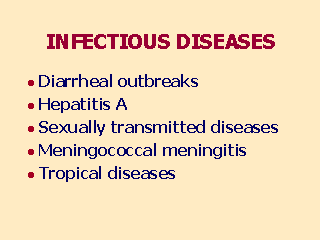 |
Soldiers almost always eat their meals in large dining
facilities. Hundreds - even thousands - of soldiers may partake of a single meal. This
puts them at risk for common source infection with gastrointestinal pathogens, such as Shigella,
Salmonella, enterotoxigenic E. coli, and hepatitis A virus. Soldiers tend to
be of an age when they are particularly active sexually, and sexually transmitted diseases
(STD’s) are a significant source of morbidity in certain armies. Living conditions in
the barracks put soldiers at risk for person-to-person transmission of infectious diseases
such as meningococcal meningitis, influenza, and measles. Deployment to tropical regions
may involve morbidity due to malaria, Leishmaniasis, and yellow fever.
|
